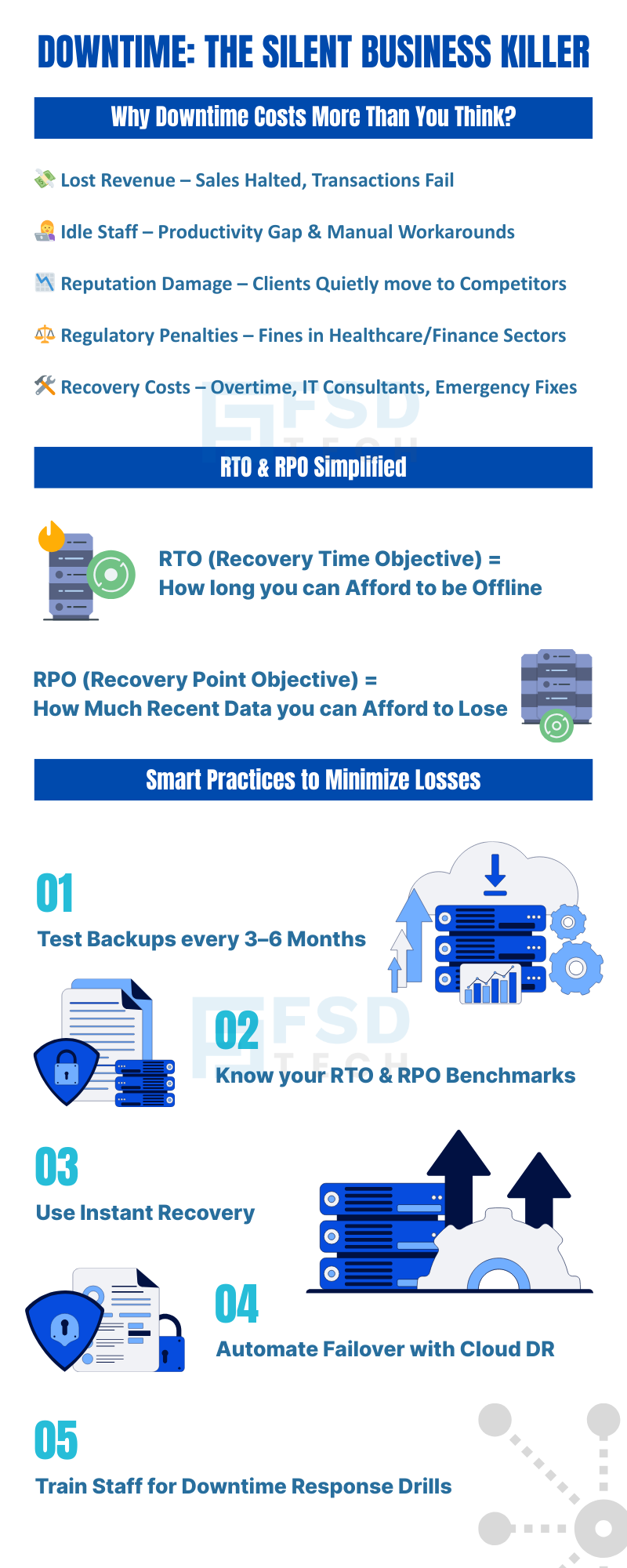
Driving ClickUp Adoption Across Teams: Building Effective Change Programs
🕓 December 7, 2025


Nasmal is a Solution Architect & Business Analyst focused on AI, Data, Automation, BCP, and Process Optimization. He helps businesses evolve from reactive to proactive, data-driven, and resilient operations. With hands-on expertise, he simplifies complex tech into clear, easy-to-understand blogs.
Share it with friends!
At exactly 9:15 AM on a Monday morning, a logistics company in Dubai had what they thought was a small IT problem — the main server went down.
At first, they thought it was just a glitch that would be fixed in an hour.
But as the minutes ticked by, the situation got worse:
By the time the systems were fully restored — 11 hours later — the damage was massive.
Here’s what it really cost them:
Final total: Over AED 250,000 lost in just one day.
And the worst part? Most of it could have been avoided if their recovery system was faster.
Downtime means your systems, applications, or data are not available for use.
It can happen for many reasons:
The key thing to remember: Even a short downtime can be expensive — not just in lost sales, but in many hidden ways.
Most business owners think downtime just means “we lose a few hours of work.”
In reality, there are many layers to the cost:
Don’t let hidden downtime costs drain your business. [Fill out the form to explore smarter recovery options with Vembu]
When downtime happens, your recovery speed determines how much money you lose.
Two important terms explain this:
If your backup system is slow, your RTO will be higher and your losses will be greater.
You can estimate downtime cost like this:
Downtime Cost = (Lost Revenue + Lost Productivity + Recovery Costs + Reputation Damage)
For some industries, this can be thousands of dirhams per hour.
For large companies, it can be millions per day.
Vembu is designed to get you back online quickly:
Recover in minutes, not hours. Click Here To Know More
A healthcare clinic in Oman was hit by a ransomware attack.
Without fast recovery, they would have had to cancel patient appointments for several days.
But with Vembu’s instant restore, they had all systems back online in under two hours — avoiding lost revenue and protecting their reputation.
Downtime is more expensive than most businesses realize.
It’s not just about the time systems are down — it’s about the sales you lose, the customers you upset, and the reputation you damage.
A slow recovery system means every minute costs more.
A fast recovery system means you can get back to work quickly, keep customers happy, and avoid major losses.
Do you know how long it would take to restore your business if disaster struck today? Let’s find out with a free RTO/RPO health check using Vembu BDR Suite. [Book your free review today]

Downtime is any period when your systems, applications, or data are not available for use.
This could mean:
In short, downtime means your normal business operations are interrupted.
Downtime can happen for many reasons, including:
Planned causes:
Unplanned causes:
Because when your systems are down:
Some costs aren’t obvious immediately but hurt you over time:
A simple formula is:
Downtime Cost = Lost Revenue + Lost Productivity + Recovery Costs + Reputation Damage
Even a small business can lose thousands of dirhams in just a few hours. For large companies, the cost can run into millions per day.
RTO is how quickly you need to get your systems back online after a problem.
If your RTO is 2 hours, that means downtime longer than 2 hours will start causing serious business damage.
RPO is how much data you can afford to lose, measured in time.
If your RPO is 30 minutes, that means you can lose at most 30 minutes’ worth of data — anything more is too costly.
The faster you can restore systems and the less data you lose, the lower your downtime cost.
Because every extra minute your systems are down costs you money and risks your reputation.
A slow recovery system means higher costs and unhappy customers.
A fast recovery system means your business gets back to normal quickly.
Instant recovery lets you start using your systems directly from the backup without waiting for a full restore.
It’s like having a spare car ready to drive immediately while your main car is still in the repair shop.
Yes — sometimes even more.
Small businesses may not have spare equipment or large IT teams, so downtime can completely stop operations and even threaten the survival of the business.
Vembu provides:
At least twice a year — but ideally every 3 months.
Regular testing shows if your backup plan actually meets your RTO and RPO targets.
The longer you go past your RTO, the higher your losses grow.
Customers may leave, contracts may be cancelled, and your brand reputation can take long-term damage.

🕓 November 24, 2025

🕓 September 16, 2025

🕓 September 5, 2025
share your thoughts